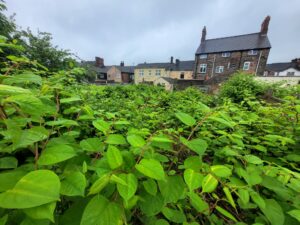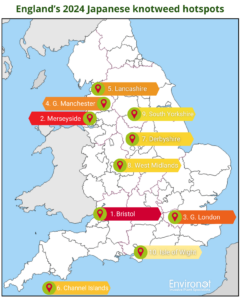Revealed: England’s 2024 Japanese knotweed hotspots
Environet has revealed England’s 2024 Japanese knotweed hotspots, showing Bristol, Merseyside and Greater London are the worst affected counties in England.
With the summer growing season now over, invasive plant specialist Environet has revealed England’s Japanese knotweed hotspots for 2024.

Photo credit: Environet
The analysis is based on the latest data from its interactive online tracker, Exposed: The Japanese Knotweed Heatmap, which is updated with new verified sightings reported by Environet’s team and members of the public throughout the year.
Now populated with almost 60,000 known infestations of Japanese knotweed, Exposed has monitored the spread of the invasive plant across the UK over the last six years, helping homeowners and homebuyers stay informed about the risk level near their property or one they wish to buy.
Users can enter their postcode to discover the number of knotweed sightings nearby, with hotspots highlighted in yellow, orange and, in the worst affected locations, red. Tapping into the growing trend for citizen science, people can also add sightings to the heatmap if they suspect a plant may be knotweed, by uploading a photo to be verified by experts.
Taking into account the different sizes of each county or unitary authority, Environet has calculated the number of known Japanese knotweed infestations per km² to identify the worst affected areas.
England’s Top Ten Japanese knotweed hotspots for 2024 are:
|
Rank |
County |
Total Incidences |
Incidences / km2 |
|
1 |
Bristol |
710 |
5.18 |
|
2 |
Merseyside |
1,611 |
2.49 |
|
3 |
Greater London |
3,592 |
2.29 |
|
4 |
Greater Manchester |
2,846 |
2.23 |
|
5 |
Lancashire |
4,556 |
1.48 |
|
6 |
Channel Islands |
281 |
1.42 |
|
7 |
Derbyshire |
2,651 |
1.01 |
|
8 |
West Midlands |
908 |
1.01 |
|
9 |
South Yorkshire |
1,417 |
0.91 |
|
10 |
Isle of Wight |
325 |
0.85 |
Source: Environet
Since the first sample was shipped to Kew Gardens from Japan in 1850, via Leiden in the Netherlands, knotweed has spread widely and there is now on average one occurrence in every 3km² in England and Wales. The unitary authority of Bristol is by far the worst affected location in England with 5.18 incidences per km², followed by Merseyside with 2.49 per km² and Greater London with 2.29 per km².

Photo credit: Environet
The origin of knotweed sightings near ports such as Bristol and Liverpool is believed to be linked to historical shipping and trading practices lacking in biosecurity. In the 19th and 20th centuries, ships returning to the UK from various parts of the world often carried ballast, including soil from foreign ports containing non-native plant material, which was then discarded to make room for the next cargo. In traditionally industrial areas such as Greater Manchester, large quantities of soil were typically moved around through mining and other activities, aiding the plant’s spread.
Over the next few weeks knotweed will start to die back, as temperatures cool and light levels drop, sending the plant into its dormant winter phase. Its green leaves will die and fall from the branches, the stems will turn brown and brittle, and after the first few frosts the plant will have completely died back, leaving only the dead canes remaining. However, the plant will re-emerge next spring, so autumn and winter is the ideal time to excavate it when the garden is not in use.
Tackling knotweed costs the UK economy nearly £250 million a year and homeowners are one of the groups most at risk – not only from potential damage to their property, outbuildings and gardens, which can be costly to repair, but also from legal risks arising from encroachment or when properties are sold. Whilst it isn’t illegal to have knotweed growing on your land, legal disputes can arise when it’s allowed to spread across property boundaries and when sellers fail to declare it to buyers.
Environet estimates that approximately 5% of homes across the UK are currently affected by Japanese knotweed, either directly or neighbouring an affected property, typically impacting property prices by around 5% – or up to 10% in severe cases.
Emily Grant, director of Environet, said:
“With over 60,000 known infestations of Japanese knotweed on our heatmap, we have a clear picture of its prevalence across the UK.
“Knotweed is easily identifiable during summer, but it’s a perennial plant so as we head through the autumn and into winter, the above-ground growth dies back and it becomes much harder to spot.
“The best way to protect your property is to be aware of the risks and ensure you can identify knotweed at different times of the year.
“If you do have knotweed on your property, it’s wise to act immediately to treat or remove it before it has the chance to spread further.
“With professional assistance knotweed can be dealt with and the value of a property largely restored.
“If you’re buying or selling a property, consider instructing a Japanese knotweed survey to check for any sign of the plant on the property and its surroundings.”
Kindly shared by Environet



















